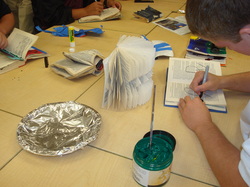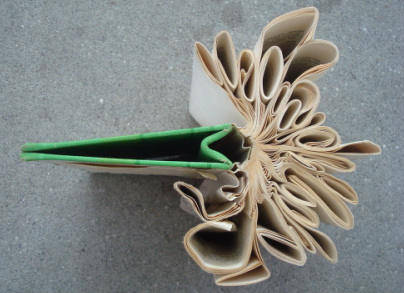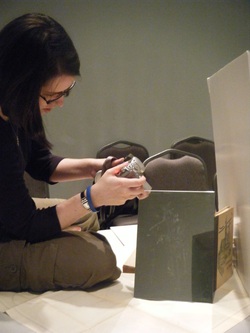Wednesday night was the opening for our Books as Art exhibit at the Main Library. The show looks good and we've only received great comments so far. Staff love the show as well and are impressed by what people made with the old books they discarded. I think it made some people realize the potencial in reusing materials, specially as an art form.
0 Comments
A few days ago, I received an email from artist Brian Dettmer who is featured in the “Books as Sculpture” portion. He was kind enough to share more artists who use books in their art as well as 2 books featuring book art. I was impressed by his interest in my project.
Artists: Ashley Schick http://www.ashleylschick.com Doug Beube http://dougbeube.com Buzz Spector http://www.buzzspector.com Robert The http://www.bookdust.com/ Books: http://www.press.uchicago.edu/ucp/books/book/chicago/B/bo11097415.html http://usshop.gestalten.com/catalog/product/view/id/4025 One thing I n stood out between the school and the library setting, is the involvement each participants had with the lessons. When students are in school, they HAVE to go to class. They might not be interested in the lessons, but we still have a chance to influence them and to get their attention. As for community-based art education, the educator / presenter has to give a performance and give their best for people to want to come back.
During the library portion, I had some participants fallout of the class for many reasons; some where overwhelmed by the artmaking part of the lessons and decided not to come back. Some had scheduling conflicts, therefore couldn't attend all the classes. In a classroom, even if the students are not interested, they are still hearing, seeing and experiencing a lesson in some way. At the library, people can get up and leave and the first impression is important. It's almost like a retail atmosphere, where we have to attract our customers and find ways to retain them.  Today, I stopped by Episcopal School to see the students’ progress on their altered books. I was surprised by the variety of work; some students took this assignment seriously, others ignored it completely. Two students decided to not do the altered books all together, for some reason. However, some students did awesome work and surprised me with the quality of the art they produced. I reminded them about the exhibition of their art for Art Walk in hopes that the stragglers would pick up the pace and finish their art on time for the exhibition, which needs to be mounted in two weeks. One thing I forgot about teenagers, is that the majority of them need to be guided and geared into projects. We need to hold their hands and set strict guidelines or else they will not do anything. I forget sometimes that creative freedom works when they are interested in the project or really want to do it. If not, laziness sets in. Reflection: Next time, I need to go back to visit them more then once a week while their projects are in progress, voice clearly my expectations, guidelines and goals I want them to meet .
For our last class “Books as Canvas”, I gave the students creative freedom in every aspect of their book creation. I decided to skip the PowerPoint presentation and instead show them different ways they could alter their book by showing them different techniques. Together, we did a found poem, teaching them how to find a poem on a page from a book; circling words, making them work together in some kind of harmony. Students followed my steps and created some impressive poems. I gave them the choice to paint or draw around their poems, so their poems can stand out from the page. I showed them one of my found poem and how illustrated it by finding an image out of magazines and glue it at the bottom of the page.
I showed them how to “erase” the text on their page to turn their book into a journal or travel log; giving them the option of collecting their writings in their book. I applied white acrylic paint on the pages, wiped it off, so we could still see the text underneath. They also had the option of creating painting, drawings, collages on their pages and turning their book into an art book, like a sketch book. The students started on their work, but didn’t have much time. We had to wrap it up and they would continue during the week. I will be going by their classrooms on Monday, October 10th, to see their progress and see if they have any questions, concerns, help… and remind them about finishing their work for the exhibition on November 2nd. For our last meeting, we talked about books becoming our canvas, an artist book, a journal… the possibilities are endless; the only constriction is that this piece of art as to remain mainly a 2D creation. I showed them a PowerPoint of different idea they could do in their books: journal, found poetry or altered book. No artists specifically, only images I found online.
Participants had the choice to draw, paint, cut, collage… anything they want. Their book could be displayed open on one page or viewers could flip through the pages. I brought so many supplies, anything they could think of doing, they could! What I didn’t think about is that most of them had no art experience at all and this “freedom” was overwhelming. Next time I will have to think about that and give specific short lessons and demonstration on some techniques they would want to try. Reflection: Adapt and be ready to demonstrate specific techniques to some people who might be “stuck”, not knowing what to do.  Today, we looked at the work of American photographer, Cara Barer. I showed them a PowerPoint presentation, showing her work and hand them a piece of paper asking simple questions and reflections. I was hoping to get more responses if they didn’t have to say it aloud; which in a way it worked. I realized after reading their comments that I had chosen images that were similar and I guess that appealed to me. I didn’t think of choosing images that were different in composition. We talked about what made a great photography composition, what they should try, what they need to think about when they take a picture. I gave them different color poster boards that could be used as backgrounds. Some went outside to take their pictures. They also had access to water spray bottle, which they could use to wet the pages of the books they chose. Some students wet the pages, some used tape to hold their book in a certain position, a lot of team work and collaboration emerged from this project. Reflection: Next time, I will choose a better variety of images to represent the body of work of an artist. The list of questions they had to answer worked very well and I would do it again next time. Maybe for all lessons, as a way to spark the conversation. This is your new blog post. Click here and start typing, or drag in elements from the top bar.
 For our book as subjects, we look at the art of photographer Cara Barer www.carabarer.com. We also talked aboutome quick tips about taking great pictures. We had different colored poster board to create a background or erase the background. Participants were asked to capture images of the books available, as well as to go explore the library. Participants either brought their camera or use their phones to take pictures. I also asked for them not to destroy the books, since we would be using them again the following week for our last art making project.
They started staging books with help of others. Asking someone to hold a poster board or holding books together. The team work that emerged from this was amazing. Specially, that most of the participants didn’t know each other. Their images came out great and they were done pretty quickly. Instead of lasting 2 hours, we cut the evening after 1 hour and 30 minutes. So far, this has been the participant's favorite class. Everyone enjoyed themselves. I setup the tables in the classroom before the students came in. I had supplies like scissors, x-acto knives, tape, glue, rulers, thread and needles… for them to use to create their sculptures. I also placed books on the tables. As the students came in, I asked them to pick a book on their table. We looked at the PowerPoint presentation and introduced them to the different artists. We also watched the video presentation by Brian Dettmer about his art. Since it was right after lunch, I was afraid they would be tired and not focused on the presentation, but they were. Students really enjoyed the video by Dettmer. They also preferred his art overall compare to the other artists. We only had 45 minutes for the presentation and the making. Students started their art right away; some cutting, some folding, some combining their books and working as a team. The students seemed to be completely immersed in their art. Their creation was impressive and they had the rest of the week to finish on their project. Reflection: I would change the order I presented the artists and I would ask for feed back right after each artist. I think we would have gotten more interaction and a more diverse dialog. As people came in for this second meeting, I asked them to choose a book that was on a cart. That will be the book they will be altering and creating a 3 dimension artwork / sculpture. These books have been discarded for numerous reasons (mold, outdated information, water damage, page missing) which prevented the sale of these books. Participants sat, looked at their books and waited for everyone to settle down. I presented different artists from different background that use books in unique ways that we can all relay to. During the PowerPoint presentation we heard a presentation of artist Brian Dettmer where he talks about his art and what pushed him to do what he does. It’s a 7 minute presentation and worth it: http://vimeo.com/6060054 After seeing the different artists, I asked very simple questions like: “who did you prefer and why?” Participants were able to discuss what they liked and there was more exchange between them then last time. They started their sculpture, some by looking at new books, some my trying different things with their books. Some already had an idea for what they wanted to make and went straight to it; others played with their books a little before starting. A sense of creative freedom was palpable in the room. Pretty much everyone was creating in some way. We had different concept going, different approaches, very personal to each participant. There were a few participants who blocked at creating something and I think this is where I was not prepared. Some people are not used to creating visual objects and I should have had a specific step-by-step project for them. I did pitch-in ideas that would work well with their abilities and book they chose, however the wide range of choices was overwhelming to them. |
|
|
 RSS Feed
RSS Feed